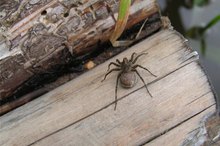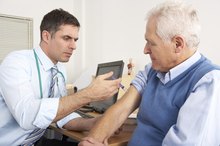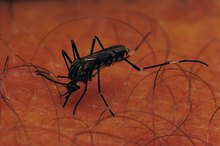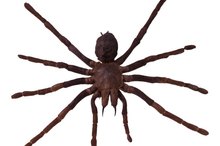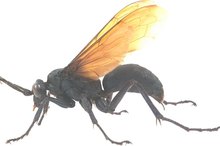Brown Widow Spider Bite Symptoms
The brown widow spider, or Latrodectus geometricus, is one of five widow spider species found in the United States 3. More than 30,000 species of spiders exist, but only a few can inflict a serious bite and produce venom harmful to humans, according to Dr. James H. Diaz and colleagues in a March 2007 article in the journal American Family Physician 1. The bite of a brown widow spider usually causes only minor problems, but in rare cases brown widow spider bite symptoms can be serious.
Localized Pain and Redness
The two main effects of a bite from a brown widow spider are pain and redness at the site of the bite, says the Center for Invasive Species Research at the University of California, Riverside. You may feel a burning pain and itchiness at the site of the bite, and small bumps might form in the reddened area of the skin.
The pain might be severe. Professor Jerome Goddard and colleagues, in a report on a rare case of a serious brown widow spider bite published in the 2008 Southern Medical Journal, noted that 10 minutes after being bitten, a 20-year-old man arrived at the hospital with pain, swelling and redness at the site of the bite 3. The patient, who was bitten in the neck, compared the pain of the bite with being hit with something "like a sledgehammer.”
- The two main effects of a bite from a brown widow spider are pain and redness at the site of the bite, says the Center for Invasive Species Research at the University of California, Riverside.
- Professor Jerome Goddard and colleagues, in a report on a rare case of a serious brown widow spider bite published in the 2008 Southern Medical Journal, noted that 10 minutes after being bitten, a 20-year-old man arrived at the hospital with pain, swelling and redness at the site of the bite 3.
Radiating Pain and Redness
What Happens When a Carpenter Bee Stings?
Learn More
Professor Godard said that a half hour after arriving at the hospital, the young man experienced increasing pain in his neck and pain expanding into his upper body. In the first reported case of envenomation by a brown widow spider in Venezuela, a woman suffered a bite in the area of her shoulder blade. Professor Demetrio Kiriakos and colleagues described the progression of her symptoms in a case study published in the Review of the Brazilian Society of Tropical Medicine. Four hours after being bitten, the patient felt moderately intense burning pain in the area of the bite. She also experienced paresthesia--an itching or tingling sensation--and redness that extended from her shoulder blade into her entire arm.
- Professor Godard said that a half hour after arriving at the hospital, the young man experienced increasing pain in his neck and pain expanding into his upper body.
- In the first reported case of envenomation by a brown widow spider in Venezuela, a woman suffered a bite in the area of her shoulder blade.
Headache and Nausea
You may develop a headache after a bite from a brown widow spider. Professor Kiriakos said that four hours after being bitten, the Venezuelan woman woke up with a steady, intense headache. Professor Godard said that a half hour after arriving at the hospital, the young man in the U.S. experienced headache, nausea, vomiting and cramps.
Muscle Spasms
Poisonous Spiders in Ontario
Learn More
After a bite from a brown widow spider, a person may experience involuntary muscle contractions. The young man who was bitten in the neck began to experience those contractions in his pectoral muscles 40 minutes after the bite. He continued to have contractions in the pectoral and quadriceps muscles six hours after the bite. The Venezuelan woman experienced generalized muscle contractions and rigidity, and cramps in her arms and legs.
- After a bite from a brown widow spider, a person may experience involuntary muscle contractions.
- The young man who was bitten in the neck began to experience those contractions in his pectoral muscles 40 minutes after the bite.
Related Articles
References
- "American Family Physicians"; Common Spider Bites; James H.. Diaz, M.D. et al.; March 2007
- University of California Statewid Integrated Pest Management Program
- "Revista da Sociedade Brasileira de Medicina Tropical"; First case of human latrodectism in Venezuela; Demetrio Kiriakos, et al.; March/April 2008
- "Journal of Venomous Animals and Toxins including Tropical Diseases"; Envenomation caused by Latrodectus geometricus in São Paulo state, Brazil: a case report; Ricardo Almeida, et al.; 2009
- Illinois Department of Public Health. Brown Recluse and Black Widow Spiders.
- Cedars Sinai Medical Center. Brown Recluse and Black Widow Spider Bites in Children.
- Sotelo-cruz N, Gómez-rivera N. [Neurotoxic manifestations of black widow spider envenomation in paediatric patients]. Neurologia. 2016;31(4):215-22. doi:10.1016/j.nrl.2015.05.007
- Williams M, Nappe TM. Black Widow Spider Toxicity. StatPearls Publishing. Updated March 8, 2019.
- Stoecker WV, Vetter RS, Dyer JA. NOT RECLUSE-A Mnemonic Device to Avoid False Diagnoses of Brown Recluse Spider Bites. JAMA Dermatol. 2017;153(5):377-378. doi:10.1001/jamadermatol.2016.5665
- Vetter RS. The distribution of brown recluse spiders in the southeastern quadrant of the United States in relation to loxoscelism diagnoses. South Med J. 2009;102(5):518-22. doi:10.1097/SMJ.0b013e3181a0abb3
- Illinois Department of Public Health. Brown Recluse and Black Widow Spiders.
- Rahmani F, Banan Khojasteh SM, et al. Poisonous Spiders: Bites, Symptoms, and Treatment; an Educational Review. Emerg (Tehran). 2014;2(2):54-8.
- Gaver-wainwright MM, Zack RS, Foradori MJ, Lavine LC. Misdiagnosis of spider bites: bacterial associates, mechanical pathogen transfer, and hemolytic potential of venom from the hobo spider, Tegenaria agrestis (Araneae: Agelenidae). J Med Entomol. 2011;48(2):382-8. doi:10.1603/ME09224
- Livshits Z, Bernstein B, Sorkin LN, Smith SW, Hoffman RS. Wolf spider envenomation. Wilderness Environ Med. 2012;23(1):49-50. doi:10.1016/j.wem.2011.11.010
- Meires J, Louden B. Bite of the Brown Recluse Spider. Clinical Review. 2010(12):14-17.
- Pagac BB, Reiland RW, Bolesh DT, Swanson DL. Skin lesions in barracks: consider community-acquired methicillin-resistant Staphylococcus aureus infection instead of spider bites. Mil Med. 2006;171(9):830-2. doi:10.7205/milmed.171.9.830
- Mikals K, Beakes D, Banks TA. Stinging the Conscience: A Case of Severe Hymenoptera Anaphylaxis and the Need for Provider Awareness. Mil Med. 2016;181(10):e1400-e1403. doi:10.7205/MILMED-D-15-00536
- Gaver-Wainwright MM, Zack RS, Foradori MJ, Lavine LC. Misdiagnosis of spider bites: bacterial associates, mechanical pathogen transfer, and hemolytic potential of venom from the hobo spider, Tegenaria agrestis (Araneae: Agelenidae). J Med Entomol. 2011 Mar;48(2):382-8.
- Isbister GK, Framenau VW. Australian wolf spider bites (Lycosidae): clinical effects and influence of species on bite circumstances. J Toxicol Clin Toxicol. 2004;42(2):153-61.
- Livshits, Z., Bernstein, B., Sorkin, L., Smith, S., & Hoffman, R. (2012). Wolf Spider Envenomation. Wilderness & Environmental Medicine, 23(1), 49-50. doi:10.1016/j.wem.2011.11.010
- Pagac BB, Reiland RW, Bolesh DT, Swanson DL. Skin lesions in barracks: consider community-acquired methicillin-resistant Staphylococcus aureus infection instead of spider bites. Mil Med. 2006 Sep;171(9):830-2.
- Payne, K., Schilli, K., Meier, K., Rader, R., Dyer, J., & Mold, J. et al. (2014). Extreme Pain From Brown Recluse Spider Bites. JAMA Dermatology, 150(11), 1205. doi:10.1001/jamadermatol.2014.605
- Robinson, J., Kennedy, V., Doss, Y., Bastarache, L., Denny, J., & Warner, J. (2017). Defining the complex phenotype of severe systemic loxoscelism using a large electronic health record cohort. PLOS ONE, 12(4), e0174941. doi:10.1371/journal.pone.0174941
- Stoecker, W., Vetter, R., & Dyer, J. (2017). NOT RECLUSE—A Mnemonic Device to Avoid False Diagnoses of Brown Recluse Spider Bites. JAMA Dermatology. doi:10.1001/jamadermatol.2016.5665
Writer Bio
Roberto Blizzard has been writing on health subjects since 2000, and has written patient and practitioner educational materials in many therapeutic areas, including cardiovascular disease, arthritis, asthma and migraine. He has edited textbooks, teachers' guides and ancillary materials, and has a degree in economics.

